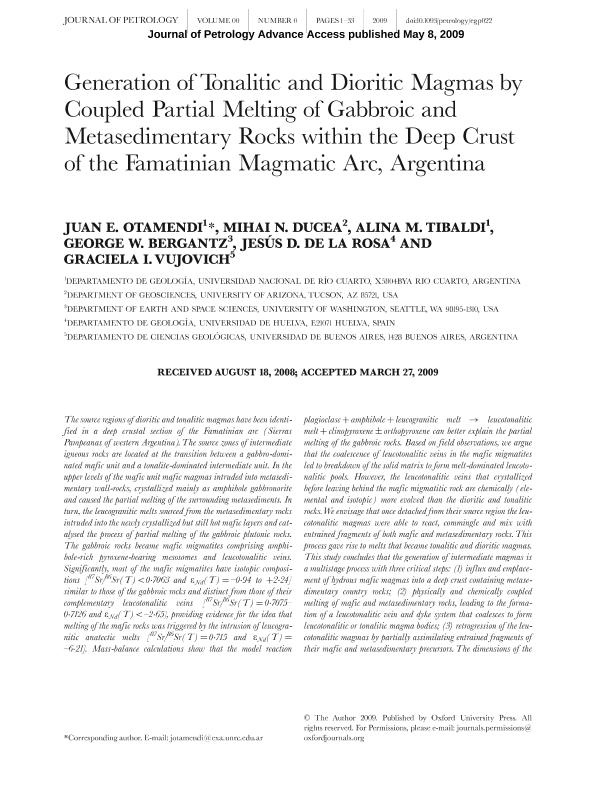Mostrar el registro sencillo del ítem
dc.contributor.author
Otamendi, Juan Enrique

dc.contributor.author
Ducea, Mihai N.
dc.contributor.author
Tibaldi, Alina María

dc.contributor.author
Bergantz, George W.
dc.contributor.author
de la Rosa, Jesús D.
dc.contributor.author
Vujovich, Graciela Irene

dc.date.available
2019-12-23T13:30:42Z
dc.date.issued
2009-05
dc.identifier.citation
Otamendi, Juan Enrique; Ducea, Mihai N.; Tibaldi, Alina María; Bergantz, George W.; de la Rosa, Jesús D.; et al.; Generation of tonalitic and dioritic magmas by coupled partial melting of gabbroic and metasedimentary rocks within the deep crust of the Famatinian magmatic arc, Argentina; Oxford University Press; Journal Of Petrology; 50; 5; 5-2009; 841-873
dc.identifier.issn
0022-3530
dc.identifier.uri
http://hdl.handle.net/11336/92728
dc.description.abstract
The source regions of dioritic and tonalitic magmas have been identified in a deep crustal section of the Famatinian arc (Sierras Pampeanas of western Argentina). The source zones of intermediate igneous rocks are located at the transition between a gabbro-dominated mafic unit and a tonalite-dominated intermediate unit. In the upper levels of the mafic unit mafic magmas intruded into metasedimentary wall-rocks, crystallized mainly as amphibole gabbronorite and caused the partial melting of the surrounding metasediments. In turn, the leucogranitic melts sourced from the metasedimentary rocks intruded into the newly crystallized but still hot mafic layers and catalysed the process of partial melting of the gabbroic plutonic rocks. The gabbroic rocks became mafic migmatites comprising amphibole-rich pyroxene-bearing mesosomes and leucotonalitic veins. Significantly, most of the mafic migmatites have isotopic compositions [87Sr/86Sr(T) < 0.7063 and εNd(T) = -0.94 to +2.24] similar to those of the gabbroic rocks and distinct from those of their complementary leucotonalitic veins [87Sr/86Sr(T) = 0.7075-0.7126 and εNd(T) < -2.65], providing evidence for the idea that melting of the mafic rocks was triggered by the intrusion of leucogranitic anatectic melts [87Sr/86Sr(T) = 0.715 and εNd(T) = -6.21]. Mass-balance calculations show that the model reaction plagioclase + amphibole + leucogranitic melt → leucotonalitic melt + clinopyroxene ± orthopyroxene can better explain the partial melting of the gabbroic rocks. Based on field observations, we argue that the coalescence of leucotonalitic veins in the mafic migmatites led to breakdown of the solid matrix to form melt-dominated leucotonalitic pools. However, the leucotonalitic veins that crystallized before leaving behind the mafic migmatitic rock are chemically (elemental and isotopic) more evolved than the dioritic and tonalitic rocks. We envisage that once detached from their source region the leucotonalitic magmas were able to react, commingle and mix with entrained fragments of both mafic and metasedimentary rocks. This process gave rise to melts that became tonalitic and dioritic magmas. This study concludes that the generation of intermediate magmas is a multistage process with three critical steps: (1) influx and emplacement of hydrous mafic magmas into a deep crust containing metasedimentary country rocks; (2) physically and chemically coupled melting of mafic and metasedimentary rocks, leading to the formation of a leucotonalitic vein and dyke system that coalesces to form leucotonalitic or tonalitic magma bodies; (3) retrogression of the leucotonalitic magmas by partially assimilating entrained fragments of their mafic and metasedimentary precursors. The dimensions of the source zone seem to be insufficient to generate crustal-scale volumes of intermediate igneous rocks. However, the Famatinian paleo-arc crust would expose only those magma source zones that were still active during the tectonic closure of the arc. Ultimately, a time-integrated perspective indicates that early active source zones were cannibalized during the downward expansion of the plutonic bodies already dominated by intermediate plutonic rocks.
dc.format
application/pdf
dc.language.iso
eng
dc.publisher
Oxford University Press

dc.rights
info:eu-repo/semantics/openAccess
dc.rights.uri
https://creativecommons.org/licenses/by-nc-sa/2.5/ar/
dc.subject
ACTIVE CONTINENTAL MARGIN
dc.subject
FAMATINIAN ARC
dc.subject
MAGMA GENESIS
dc.subject
PARTIAL MELTS
dc.subject
PLUTONIC ROCKS
dc.subject.classification
Geoquímica y Geofísica

dc.subject.classification
Ciencias de la Tierra y relacionadas con el Medio Ambiente

dc.subject.classification
CIENCIAS NATURALES Y EXACTAS

dc.title
Generation of tonalitic and dioritic magmas by coupled partial melting of gabbroic and metasedimentary rocks within the deep crust of the Famatinian magmatic arc, Argentina
dc.type
info:eu-repo/semantics/article
dc.type
info:ar-repo/semantics/artículo
dc.type
info:eu-repo/semantics/publishedVersion
dc.date.updated
2019-10-10T19:32:22Z
dc.journal.volume
50
dc.journal.number
5
dc.journal.pagination
841-873
dc.journal.pais
Reino Unido

dc.journal.ciudad
Oxford
dc.description.fil
Fil: Otamendi, Juan Enrique. Universidad Nacional de Río Cuarto; Argentina
dc.description.fil
Fil: Ducea, Mihai N.. University of Arizona; Estados Unidos
dc.description.fil
Fil: Tibaldi, Alina María. Universidad Nacional de Río Cuarto; Argentina
dc.description.fil
Fil: Bergantz, George W.. University of Washington, Seattle; Estados Unidos
dc.description.fil
Fil: de la Rosa, Jesús D.. Universidad de Huelva; España
dc.description.fil
Fil: Vujovich, Graciela Irene. Consejo Nacional de Investigaciones Científicas y Técnicas. Oficina de Coordinación Administrativa Ciudad Universitaria. Instituto de Estudios Andinos "Don Pablo Groeber". Universidad de Buenos Aires. Facultad de Ciencias Exactas y Naturales. Instituto de Estudios Andinos "Don Pablo Groeber"; Argentina
dc.journal.title
Journal Of Petrology

dc.relation.alternativeid
info:eu-repo/semantics/altIdentifier/doi/http://dx.doi.org/10.1093/petrology/egp022
dc.relation.alternativeid
info:eu-repo/semantics/altIdentifier/url/https://academic.oup.com/petrology/article/50/5/841/1600498
Archivos asociados
